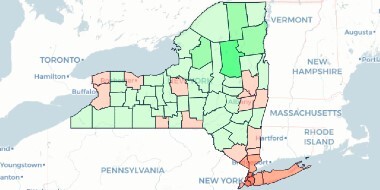Consumer Behavior
Shifts in U.S. Consumers’ Preferences Amid COVID-19 Make Business Agility Essential
June 22, 2020 | Written by: Jesus Mantas
Categorized: Consumer Behavior | COVID-19
Share this post:
 As we move through the pandemic, and states and businesses in the United States begin to carefully re-open, U.S. consumers’ attitudes toward life and work are continuing to evolve, according to new research from the IBM Institute for Business Value (IBV).
As we move through the pandemic, and states and businesses in the United States begin to carefully re-open, U.S. consumers’ attitudes toward life and work are continuing to evolve, according to new research from the IBM Institute for Business Value (IBV).
The IBV polled more than 18,000 U.S. adults in May and early June to understand how COVID-19 has affected their perspectives on topics that include remote work; the return to the workplace; where they want to live; how they want to shop; and their preferred forms of transportation. The research follows a similar study conducted in April, which had already identified significant shifts in consumer attitudes as a result of the pandemic.
The results signal that consumers are preparing themselves for more permanent changes in behavior because of the pandemic and their fears about future outbreaks. Two of every three respondents said they were concerned about a second wave of COVID-19 hitting later in 2020. More than 60 percent said they believed there were likely to be more global pandemic events like COVID-19 in the future.
The new research suggests that organizations in every industry must pay attention to their customers’ shifting preferences. And they must respond with agility: by adopting technology, rethinking processes and most importantly addressing culture in order to emerge from the pandemic smarter and stronger.
Living in Urban Areas Is Becoming Less Desirable
Nearly one in five urban residents in the survey indicated they would definitely relocate or would consider moving to suburban or rural areas as a result of the pandemic. Fewer than 1 in 10 indicated they now found living in an urban area more appealing.
The likely population shifts resulting from these changing attitudes would significantly impact local infrastructure and support systems. That would include changes in traffic patterns; loads on cell and broadband networks; demands on emergency response services; and use of online government portals and systems for taxes, unemployment claims and other citizen activities. Given that 2020 is a census year in the U.S., it is especially important to capture these trends as governments plan the next stage of public investments.
Local governments will need to look to technology to help them build smarter, more resilient and citizen-centric infrastructure that can scale up or down based on need. Hybrid cloud platforms, cognitive assistants and self-service tools can help ease the intensifying strain on citizen services during the pandemic and improve adaptability in the long run.
Given the change in perception with respect to urban areas, local governments will also need to develop services and community spaces— restaurants, outdoor spaces, arts and culture attractions—that establish an appealing brand for prospective residents.
Mobility Patterns Will Change—and Personal Vehicles Are Likely to Win
In an abrupt shift from pre-pandemic trends, consumers indicated they will use personal vehicles more and will reduce their use of shared transportation services.
One in four respondents said they would use their personal vehicles exclusively as their mode of transport, and an additional 17 percent said they’d use them more than before. A full 60 percent of those who want to use a personal vehicle but don’t already own one said they would buy one. The remainder in this group said they would rent a vehicle until they felt safe using shared mobility.

A video highlighting insights from IBM Institute for Business Value about consumer preferences and behaviors amid COVID-19.
More than half—53%—said they would reduce use of, or no longer use, public transportation like buses, subways or trains.
Slightly more than half of people who used shared mobility services (e.g. public transportation, ride hailing and traditional taxis) said they would now use them less or not at all. Of those respondents, nearly half said that travelers would need to use face coverings and social distancing methods before they would resume using shared mobility services at the level they did prior to the pandemic; more than one third indicated that transit providers’ trustworthy use of disinfectant policies and methods would make a difference in their behavior.
The data also show a rise in preference for personal vehicles. One in four respondents said they would use their personal vehicles exclusively as their mode of transport, and an additional 17 percent said they’d use them more than before.
A full 60 percent of those who want to use a personal vehicle but don’t already own one said they would buy one. The remainder in this group said they would rent a vehicle until they felt safe using shared mobility.
To adapt to these new mobility patterns and preferences, the auto industry must provide an increasingly customer-centric experience—one focused on deeper customer relationships instead of transactions alone. Sales associates and dealerships will need to adopt digital services like virtual assistants, contactless delivery, and augmented reality (AR) apps for remote diagnostics, and how-to manuals to make the experience of pre-sale, sale and service more personalized and digitized.
Shared mobility services like ride-hailing platforms will need to continue to improve their virtual tools and assistants to personalize customers’ experience. Clear communication about the cleanliness and safety of each vehicle via ride-hailing apps will be critical to gaining consumers’ trust.
Remote Work Is Here to Stay
Before COVID-19 containment measures went into effect, less than 11% of respondents worked from home. As of June 4, that percentage had expanded to more than 45%.
What’s more, 81% of respondents—up from 75% in April—indicated they want to continue working remotely at least some of the time. More than half—61%—would like this to become their primary way of working.
Given these new preferences, organizations must rethink work in the context of the new possibilities and challenges. Employees and employers alike have embraced benefits of working remotely for some tasks, including reduced travel time and improved productivity. However, they also recognize the limitations and risks of remote work, like the potential loss of rich collaboration, and the need for a new set of tools to encourage engagement. Leading companies will emerge stronger by fully embracing a new set of modern collaborative work tools, and most importantly, dedicating time and resources to build an agile, open culture and leadership models among their employees.
Businesses also need to adopt technology and systems that can prevent technical problems and address new cybersecurity threats that are likely to grow as remote work becomes more common. For security in particular, it will be critical to design secure frameworks for systems at risk of exposing intellectual property, client and employee data, as well as collaboration tools like video conferencing platforms, and file sharing platforms.
Employees Will Demand a Careful Re-Entry to On-Site Work
When asked what steps employers should take in returning to on-site work operations, many respondents felt strongly that their employers should deploy broad measures to protect them from exposure to the virus and to allow them the flexibility they need to ensure their mental health and well-being.
More than half of respondents said there must be clear communication with employees about what is being done to sanitize the workplace. And nearly half also said employers should require social distancing in the workplace and clearly communicate about what would happen in case of another outbreak.
Half said employers should provide paid leave for people who are sick or have symptoms. And nearly one in three feel strongly that their employer should provide special accommodations for individuals to address childcare needs.
Given these attitudes, it’s clear that organizations must have a data-driven, evidence-based plan for the return to the workplace—to balance their enterprise’s productivity with employees’ need to feel comfortable and safe in returning in person.
A separate new IBM IBV report, “The CHRO’s guide to workforce re-entry,” outlines key focus areas for chief human resource officers. The priorities include rethinking how overall workflows can be made smarter; making data-driven decisions for each phase of re-opening while protecting employee data; and building an adaptable workforce culture that empowers employees to innovate at the speed of the market.
Consumers’ Retail Preferences Have Shifted Significantly
In the May-June survey, consumers’ perspectives on shopping remained fairly consistent with what was reported in April. More than one third—35%—of consumers in the more recent survey said they were likely to use contactless payment options (e.g. via their mobile device or credit card) when shopping, as a result of COVID-19.
And more than 75% of respondents indicated they were choosing to visit stores to buy essential goods (e.g., food & beverages and household & cleaning products). One in four respondents indicated they were shopping more often at locally owned stores and buying more locally made, grown or sourced products.
In response, consumer brands are now moving into a more thoughtful, proactive stage looking for hyperlocal demand insights to better serve their customers. Many are using AI to look for patterns in the demand signals and starting to realign production, potentially with local sourcing, and adjust supply chains accordingly.
The Take-Away
Customer behaviors have changed in response to the pandemic, with many people embracing more digital experiences across all aspects of their lives. Many of those changes will be permanent. Across every industry, organizations are seeking to better understand these changing needs and adjust products, services, policies and culture to not only adapt, but also to emerge stronger.
The future is still uncertain, of course. But there are two trends that seem likely to differentiate winning enterprises: accelerated adoption of technology, specifically Cloud and AI; and investment in people, culture and skills as much or more as they invest in technology.
It is the combination of great technology with engaged, agile employees that will create the winning experience and value propositions that consumers are demanding.

Jesus Mantas is senior managing partner, IBM Services.
Igniting the Dynamic Workforce in Your Company
In the rapid push to moving to remote work, we’ve seen digital strategies accelerate by years – transforming their workplaces, workstyles, and business processes forever. Overnight, remote workforces put advanced environments of multi-device mobility, dynamic connection points and robust cloud-based apps that ease communication and collaboration. A new normal is emerging, led by the companies aggressively adopting cloud […]
Lessons from Space May Help Care for Those Living Through Social Isolation on Earth
Since the Crew Dragon spacecraft arrived at the International Space Station (ISS) on May 31, NASA astronauts Bob Behnken and Doug Hurley have been busy—according to their Twitter posts, even working over the weekend to repair the ISS treadmill. They likely don’t have much time to think about being lonely and cut off from life […]
Reopening the Economy: How AI Is Providing Guidance
As communities take various measures to reopen for business while reducing the risk of further COVID-19 outbreaks, navigating the recovery is daunting. It’s a historic juggling of public health considerations with the need to revive the economy. Business and community leaders are struggling to pilot through a dense fog. For us at Wunderman Thompson, a […]


